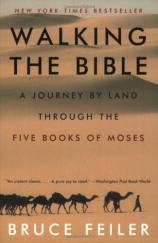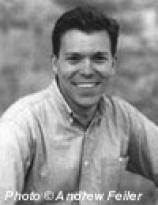Excerpt
Excerpt
Walking the Bible: A Journey Land Through the Five Books of Moses

Chapter One
In the Land of Canaan
The guard eyed me squarely as we approached his post, moving one hand from his belt to his walkie-talkie. His other arm rested on a rifle. He had gel in his hair and three stripes on his sleeve. "Yes?" he said, arching his eyebrows.
It was 9:35 on a late-autumn morning when Avner and I strode toward the security checkpoint at the Damia Bridge, an Israeli-Jordanian border crossing about thirty miles north of Jericho. We had driven up from Jerusalem that morning to start the next phase of our journey, visiting sites in the Promised Land associated with Abraham, his son Isaac, and his son Jacob. Together they form the holy triumvirate of biblical forefathers, the patriarchs, from the Greek words patria, meaning family or clan, and arche, meaning ruler. The Five Books describe several forefathers who preceded these men, notably Adam and Noah, as well as many who follow. But the three patriarchs receive special distinction because it's to them -- of all humanity -- whom God grants his sacred covenant of territory, and through them that the relationship between the people of Israel and the Promised Land is forged.
The story of the patriarchs takes up the final thirty-nine chapters of Genesis and covers the entire geographical spectrum of the ancient Near East, from Mesopotamia to Egypt, and back again, all within several verses. For Avner and me, this scope posed a challenge. Soon after our return from Turkey, we huddled in the living room of his home in Jerusalem and set about devising an itinerary. It was a sunny, comfortable room, with whitewashed walls, bedouin rugs from the Sinai, and pictures of his two children, as well as the two daughters of his second wife, Edie, a Canadian who served as office manager for the Jerusalem bureau of the New York Times. Avner sat at the table with his computer, online Bible, countless topographical maps, dozens of archaeological texts, and the handheld GPS device, while I paced the floor.
Our most immediate problem was that with no archaeological evidence to relate any of the events in the Five Books to specific places, we were left to the often-contradictory claims of history, myth, legend, archaeobiology, paleozoology, and faith. There are nearly two dozen candidates for Mount Sinai, for example, and nearly half a dozen for the Red Sea. There are countless theories about which path the Israelites took through the Sinai. In addition, we faced the competing constraints of religious wars, political wars, terrorism, climate, budget, and health, as well as the desire to have fun.
Ultimately we settled on a guiding principle: Our goal was to place the biblical stories in the historical and cultural context of the ancient Near East. Time and again, rather than focus on every story in the text, or even every interesting story in the text, we decided to concentrate on stories that could be enhanced by being in the places themselves. The story of Jacob and his brother Esau wrestling in Rebekah's womb, for example, while fascinating on many levels, struck us as not likely to be enriched by traveling to a specific location. The stories of Sodom and Gomorrah, by contrast, and the crossing of the Red Sea might easily take on new meanings by visiting their settings. In Judaism, the traditional process of analyzing scripture is called midrash, from the Hebrew term meaning search out or investigate; in Christianity, this process is referred to as exegesis, from the Latin word meaning the same thing. In effect, what Avner and I undertook was topographical midrash, a geographical exegesis of the Bible.
In that spirit, we decided to begin our travels in Israel with a bit of a long shot. Our destination this morning was Shechem, the first place Abraham stops in Canaan and the next place the Bible mentions after Harran. The text makes no mention of what route Abraham, his wife, Sarah (she's actually called Sarai at the moment, as he is still called Abram), and his nephew Lot took to Canaan. Based on road patterns in the ancient world, one of the most logical places for him to cross into the Promised Land would have been a natural ford in the Jordan River just south of the Sea of Galilee, where the Damia Bridge is located today. Though we were already in the Promised Land, we decided to ask if the Israeli Army would let us walk across the bridge to the Jordanian side, then walk back, seeing what Abraham might have seen. Avner explained this idea to the sergeant, who remained at attention. After hearing the explanation, the officer removed his walkie-talkie and relayed our request.
The border post was astir that morning. It was a small crossing -- the Jordan here is narrow enough for a horse to jump -- but tidy, decorated with cacti, olive trees, and oleanders. The gate was blue and white. Every few minutes a Palestinian truck would approach, ferrying oranges, honeydew, or polished limestone. The driver would dismount and hand over his papers, which the guards would stamp and return. Then the guards would roll open the gate, the truck would pass, and the whole process would start again. We were just becoming lulled by the routine, when suddenly we heard static on the walkie-talkie. The sergeant removed it and held it for us to hear: "I don't care if they write a book about the Bible," the voice said. "I don't care if they rewrite the Bible itself. But they're not going to do it in a military zone, and they're not going to do it on my bridge."
The sergeant replaced his walkie-talkie and shrugged. "Sorry," he said, "only Palestinians."
We returned to the highway and turned west toward the mountains. Shechem is located at the northern edge of the central spine of mountains that traverse much of Israel and the West Bank…
Excerpted from Walking the Bible © Copyright 2002 by Bruce Feiler. Reprinted with permission by HarperPerennial. All rights reserved.
Walking the Bible: A Journey Land Through the Five Books of Moses
- paperback: 480 pages
- Publisher: Harper Perennial
- ISBN-10: 0380807319
- ISBN-13: 9780380807314








